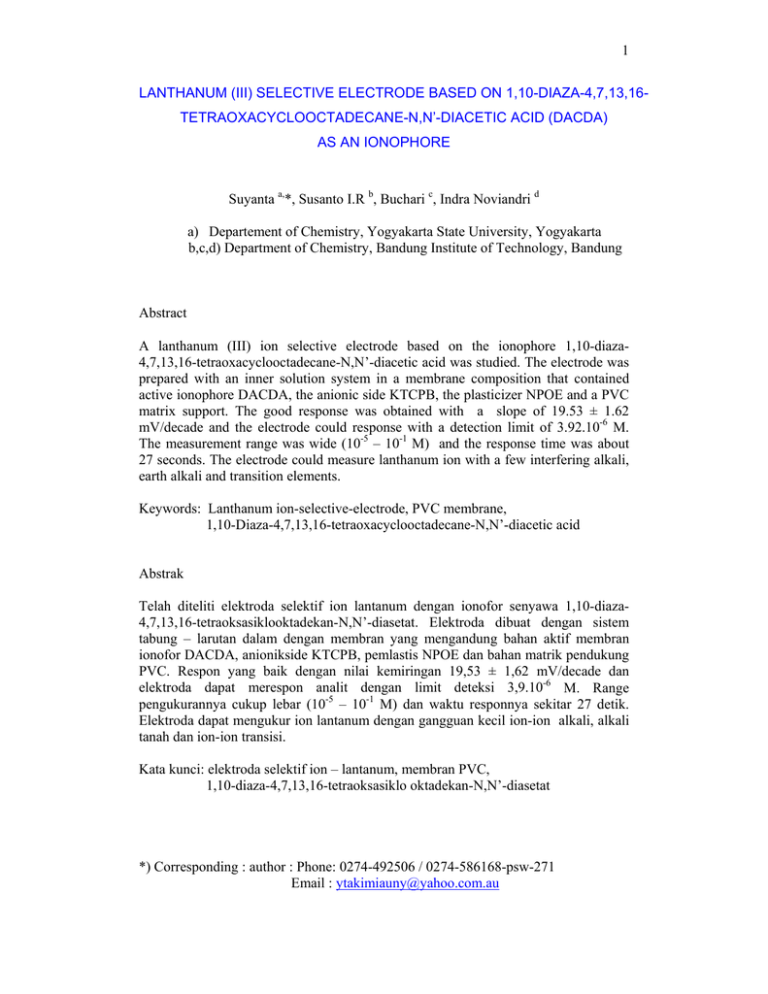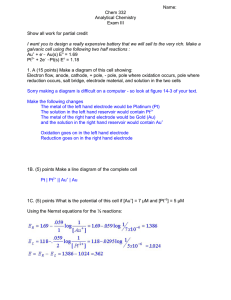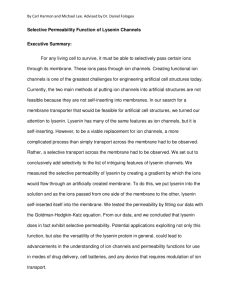1 LANTHANUM (III) SELECTIVE ELECTRODE BASED ON 1,10-DIAZA-4,7,13,16- TETRAOXACYCLOOCTADECANE-N,N’-DIACETIC ACID (DACDA)
advertisement

1 LANTHANUM (III) SELECTIVE ELECTRODE BASED ON 1,10-DIAZA-4,7,13,16TETRAOXACYCLOOCTADECANE-N,N’-DIACETIC ACID (DACDA) AS AN IONOPHORE Suyanta a,*, Susanto I.R b, Buchari c, Indra Noviandri d a) Departement of Chemistry, Yogyakarta State University, Yogyakarta b,c,d) Department of Chemistry, Bandung Institute of Technology, Bandung Abstract A lanthanum (III) ion selective electrode based on the ionophore 1,10-diaza4,7,13,16-tetraoxacyclooctadecane-N,N’-diacetic acid was studied. The electrode was prepared with an inner solution system in a membrane composition that contained active ionophore DACDA, the anionic side KTCPB, the plasticizer NPOE and a PVC matrix support. The good response was obtained with a slope of 19.53 ± 1.62 mV/decade and the electrode could response with a detection limit of 3.92.10-6 M. The measurement range was wide (10-5 – 10-1 M) and the response time was about 27 seconds. The electrode could measure lanthanum ion with a few interfering alkali, earth alkali and transition elements. Keywords: Lanthanum ion-selective-electrode, PVC membrane, 1,10-Diaza-4,7,13,16-tetraoxacyclooctadecane-N,N’-diacetic acid Abstrak Telah diteliti elektroda selektif ion lantanum dengan ionofor senyawa 1,10-diaza4,7,13,16-tetraoksasiklooktadekan-N,N’-diasetat. Elektroda dibuat dengan sistem tabung – larutan dalam dengan membran yang mengandung bahan aktif membran ionofor DACDA, anionikside KTCPB, pemlastis NPOE dan bahan matrik pendukung PVC. Respon yang baik dengan nilai kemiringan 19,53 ± 1,62 mV/decade dan elektroda dapat merespon analit dengan limit deteksi 3,9.10-6 M. Range pengukurannya cukup lebar (10-5 – 10-1 M) dan waktu responnya sekitar 27 detik. Elektroda dapat mengukur ion lantanum dengan gangguan kecil ion-ion alkali, alkali tanah dan ion-ion transisi. Kata kunci: elektroda selektif ion – lantanum, membran PVC, 1,10-diaza-4,7,13,16-tetraoksasiklo oktadekan-N,N’-diasetat *) Corresponding : author : Phone: 0274-492506 / 0274-586168-psw-271 Email : ytakimiauny@yahoo.com.au 2 1. INTRODUCTION Rare earth elements are known as important inorganic compounds, because of their properties, especially their strong magnetic property. One of the important elements is lanthanum. The available methods for low level determination of rare earth ions in solution include, ICPMS, ICPAES, and X-ray fluorescence spectrometry, etc.1-2 These methods are either time consuming, involving multiple sample manipulation and too expensive for most analytical laboratories. Ion selective electrode (ISE) in potentiometry is one method of analysis that is simpler and inexpensive but can used as a good method. Ion selective electrodes with neutral carriers were developed for some elements especially for alkali, earth alkali and transition elements. They are successful methods for analysis. For rare earth elements, a very little work on the system have been done by some researcher. Only a few reports are found in the literature on the preparation of ore rare earth ion selective electrodes.3-4 For this reason, we tried prepare an ion selective electrode for rare earth elements, especially for lanthanum. Macrocycle compounds have properties to form complex compounds with some metals. In this case, macrocycles function as ligand.5 For example, crown ethers with alkali and earth alkali metal ions to form very specific complex compounds. Macrocycles with N (nitrogen) element usually form complex compounds with transition elements. Chang C.A. and Ochaya, synthesized the macrocycle compound lariat diaza 18 C 6 (1,10-diaza-4,7,13,16-tetraoxacyclooctadecane-N,N’-diacetic acid and 1,7-diaza-4,10,13-trioxacyclooctadecane-N,N’diacetic acid) and studied complexation with rare earth elements. They concluded that compounds are selective reagents for lanthanide ions.6 For this reason, we tried make an ion selective electrode for lanthanum with the compound lariat diaza 18 C 6. We focused on two kinds of macrocycle compound with structures given in figure 1.5 I. Dimethoxy diaza 18 C 6 II. Dacetic acid diaza 18 C 6 Figure 1: Structures of the macrocycle lariat diaza 18 C 6 compound 3 Ion selective electrode membranes are typically investigated under zero current conditions as a galvanic cell. With the outer reference calomel electrode and inner reference Ag/AgCl electrode, the cell construction is : Hg/Hg2Cl2/KCl(sat): 3 M KCl ∶∶ Sample solution ∥ membrane ∥ internal filling solution / AgCl/Ag The electromotive force (emf) a cross this cell is the sum of all individual potential contributions. The emf value of the membrane system generally dependent to membrane potential. Membrane is usually interposed between the sample and an inner reference electrolyte. It is common to divide the membrane potential (Em) into three separate potential contributions, namely the phase boundary potential (EPB) at both interfaces and the diffusion potential (EDiff) within the ion selective membrane.7 Em = EDiff + 2 EPB ……………………………………………………… 1 For ion selective electrode, the membrane internal diffusion potential is zero if no ion concentration gradients occur. The concentration of ion in the inner solution is constant, so the phase boundary potential in inner interface is constant. From the assumption value Em is: Em = EConst + EPB ……………………………………………………… 2 Where EPB is the phase boundary potential at the membrane sample interface. The value of phase boundary potential can be derived from a basic thermodynamic consideration. First, the electrochemical potential, (µe) , is formulated for the aqueous phase and organic phase. Finally, the membrane potential can derived and result the equation as follow : RT Em = Eo + ------- ln ai (aq) ................................................................................ zF 3 This equation is called the Nernst equation. From the equation we can see that membrane potential is only identical with a number analyte ion activity. 2. EXPERIMENTAL 2.1. Reagents A stock solution (10-1 M) of lanthanum (III) was prepared by dissolving LaCl3.7H2O (99.9 % purity, Merck, Germany) in distilled water. The ionophore 1,10-diaza4,7,13,16-tetraoxacyclooctadecane-N,N’-diacetic acid was purchased from ACROS ORGANIC, New Jersey, USA. The plasticizer of o-nitrophenyl octyl ether (NPOE) 4 and anionic side potassium tetrakis (4-chlorophenyl) borate (KTCPB) were purchased from Fluka Chemie AG, Switzerland. Tetrahydrofuran (THF) used for dissolving the membrane components was purchased from Merck. All other chemicals used in analytical determinations were guaranted reagent grade purity. 2.2. Membrane and electrode preparation The membrane solution was prepared by dissolving 10.0 mg 1,10-diaza-4,7,13,16tetraoxacyclooctadecane-N,N’-diacetic acid, 45 mg PVC, 90 mg NPOE and 5 mg KTCPB in 3 mL of THF. The solution was evaporated on a plane glass with an area of 1.5 x 4 cm2. The electrode was prepared by gluing the electrode tube to the membrane. The inner reference electrode Ag/AgCl and the inner solution (a mixture of 10-3 M KCl and 10-3 M La3+) is set in the tube and connected to coaxial cable. The electrode was conditioned before potentiometric measurement by immersing it into 10-3 M LaCl3 solution for 24 hours. 2.3. Electrode system and EMF measurement The cell configuration used for potentiometric measurement was of the type: Hg/Hg2Cl2/KCl(sat): 3 M KCl ∶∶ Sample solution ∥ membrane ∥ internal filling solution / AgCl/Ag EMF measurements were carried out with a calomel electrode (ORION) coupled with an ORION pH/Ion-meter 420A. The concentrations of lanthanum (III) ion in the sample solutions were varied from 10-1 to 10-8 M in stirred solutions. The EMF values were recorded when the reading on ion-meter became stable. The pH values of the sample solutions were adjusted with NaOH and HCl/HNO3 and measured with a pH-meter. The activity of metal ion was calculated based on their activity coefficient, γ , as calculated from the modified Debye Huckel equation: Log γ = - 0,511 Z2 [ √ µ / (1+1,5 √µ) ) - 0,2 µ ] Where µ is ionic strength and Z is the valence of the concerned ion. All the EMF measurements were performed at 25 ± 3 oC. 3. RESULTS AND DISCUSSION 3.1. Response characteristics of La(III)-selective electrode The potential response of the electrode was affected by the composition of the membrane electrode. For this reason we varied the composition of the membrane to 5 result in a good potential response. The variation of the membrane electrode can be seen in table 1. Table 1. Composition of the membrane electrode and their Nernstian response No PVC (mg) NPOE (mg) DACDA (mg) KTCPB (mg) Slope 1 44.6 (32.32%) 83.0 (56.42%) 14.4 (9.79%) 5.1 (3.47%) 12.27±1.51 2 45.3 (30.54%) 82.5 (55.63%) 10.2 (6.87%) 10.3 (6.95%) 18.51±1.11 3 45.5 (30.11%) 90.2 (59.69%) 10.0 (6.62%) 5.4 (3.57%) 19.53±1.62 4 49.4 (32.93%) 90.1 (60.06%) 5.2 (3.47%) 5.3 (3.53%) 21.50±1.72 5 50.0 (33.67%) 90.2 (60.74%) 5.1 (3.43%) 3.2 (2.15%) 34.19±3.06 6 50.2 (34.15%) 90.2 (61.36%) 5.0 (3.40%) 1.6 (1.09%) 33.03±0.76 From the data, it can be seen that the composition with 6.87 % ionophore DACDA and 3.57 % KTCPB gave a Nernstian response with a slope of 19.53 mV/decade. 3.2. Effect of pH on the potential response We prepared a series of solutions of La3+ with the pHs ranged from 1 to 10, by adding HCl and NaOH solutions. Solution potentials were measured by the cell E (mvolt) system and the results can be seen in figure 2. 140 120 100 80 60 40 20 0 0 1 2 3 4 5 6 7 8 9 10 11 12 13 14 pH of solution Figure 2: Effect of pH on the potential response Figure 2 shows that potential responses were relatively constant at pH 3 to 8 but then dropped to 10. This is because the lanthanum ion was precipitated to form metal hydroxide. So, we worked at pH 4.5. This results are relative same with some researcher that pH is constant at 3 – 9.8-9 6 3.3. Effect of macrocycle lariat compound To see the effect the structure of the macrocycle compound we compared two kinds of macrocycle lariat compound. They were (1,10-diaza-4,7,13,16- tetraoxacyclooctadecane-N,N’-diacetic acid (ionophore 1) and N,N’-bis-methoxy methyl-1,10-diaza 18 crown 6 (ionophore 2). The capability of the electrode can be seen from its potential response in figure 3. 240 220 E (mV) 200 180 Ionophor 1 160 Ionophor 2 140 120 -9 -8 -7 -6 -5 -4 -3 -2 100 -1 0 Log Concentration (M) Figure 3: Electrode potential response characteristics of the two ionophores. From figure 3 we can see that the electrode with ionophore 1 had better response than those with ionophore 2. Detection limit of the electrode with ionophore 1 was better than that with ionophore 2. Range measurement of the electrode 1 was wider than that of electrode 2 (electrode 1: 10-5 – 10-1 M and electrode 2: 10-5 – 10-2 M). The electrode with DACDA ionophore could response about 27 seconds and had a life time of about 2 month. 3.4. Selectivity of electrode The potentiometric selectivity coefficient which reflects the relative response of the membrane sensor for the primary ion over other ions present in solution were investigated by the match potential method (MPM)10-11. The results of comparison between the potential response of primary ion and interfering ions can be seen in figure 4. 7 240 220 Na+ K+ Ca2+ Mg2+ Zn2+ Pb2+ La3+ Cu2+ emf (mvolt) 200 180 160 140 120 100 -7 -6 -5 -4 -3 -2 -1 Concentration (-log M) Figure 4: Potential response of La-ISE to La3+ ion and to other ions From the data in figure 4, the value of K APot, B is calculated with the MPM system. The results for all interfering ion can be seen in table 2. Tale 2: Selectivity coefficient of various interfering ions* Mn+ K APot, B Na+ 7,10.10-4 K+ 5,36.10-3 Ca2+ 2,94.10-4 Mg2+ 8,85.10-4 Zn2+ 3,24.10-4 Pb2+ 4,46.10-3 Cu2+ 1,99.10-2 *) Conditions: reference solution 1.10-7 M LaCl3, 10-6 – 10-1 M La3+ primary ion (A) and 10-2 M Mn+ interfering ion (B) As is seen, for alkali, earth alkali and some transition ions have selectivity coefficient values in the order of 10-3 – 10-2. This indicates that they did not disturb the function of La-ISE. But for the rare earth ions, they relatively disturbed its function, in the measurement of La3+ ion. The results are match with the Chang and Ochaya results that the DACDA is a selective reagent to rare earth elements. This can be seen to the log KMLM value with DACDA in table 3. 8 Table 3: Stability constant of metals complexes of tetraoxacyclooctadecane-N,N’-diacetic acid 1,10-diaza-4,7,13,16- Metal ions Ionic radii, Å log KMLM (DACDA) 2+ Ca 1.12 8.39 2+ Sr 1.26 8.29 Ba2+ 1.42 7.63 Ni2+ 0.69 7.39 2+ Cu 0.73 14.49 Zn2+ 0.74 8.42 Cd2+ 1.10 11.07 Pb2+ 1.29 13.55 La3+ 1.160 12.21 3+ Ce 1.143 12.23 Pr3+ 1.126 12.22 Nd3+ 1.109 12.21 3+ Sm 1.079 12.12 Eu3+ 1.066 12.02 Gd3+ 1.053 11.93 3+ Tb 1.040 11.70 Dy3+ 1.027 11.57 Ho3+ 1.015 11.18 3+ Er 1.004 11.30 Tm3+ 0.994 11.10 3+ Yb 0.985 10.90 Lu3+ 0.977 10.84 *) The data are refers to Chang & Ochaya, 189, 84. 3.5. Application The electrode was used to measure the content of lanthanum ion in waste water samples from a chemical laboratory at Bandung Institute of Technology. We compared the analysis with those using ICP-AES method. The results can be seen in table 4 showing that the two methods produced the relatively comparable results. The application of potentiometric titration using La-ISE as a working electrode was done it. The results of the titration can be seen in figure 5. The method could measure lanthanum ion with a relatively low error. 1 Table 4: Results of analysis of La3+ in samples using La-ISE and ICP-AES methods 150 E cell (mvolt) 140 Number La3+ 130 Sample 120 added ISE 1 5.10 M 1.9 10 M 1.2 10-4 M 100 2 5.10-5 M 4.1 10-5 M 5.0 10-5 M 3 5.10-6 M 3.1 10-6 M 4.9 10-6 M 0 0.1 0.2 0.3 0.4 0.5 -4 ICP-AES 110 Volum e of EDTA (m L) -4 Recovery Figure 5: Potentiometric titration of 25 mL 10-5 M La3+ with 5.10-3 M EDTA using La-ISE 4. CONCLUSIONS This work describes potentiometric study using La-ISE with the ionophore lariat diaza 18 crown 6 compounds in membrane electrode. This La-ISE is useful for the measurement of lanthanum ion with a few interfering alkali, earth alkali and transition elements. 5. ACKNOWLEDGEMENTS The present work was supported by the BPPS scholarship from the Directorate of Higher Education of Indonesia (DIKTI). The writer would like to express a deep gratitude to Prof. Susanto Imam Rahayu, PhD, Prof. Dr. Buchari and Dr. Indra Noviandri as partners in this research. Deep gratitude is also to all staff of Chemistry Department, Faculty of Science, Bandung Institute of Technology. 2 REFERENCE 1. Houk, R.S., Fassel, F.A., Flesch, G.D., and Svec H.J., “Inductively-coupled argon plasma as an ion source for mass spectrometric determination of trace elements”, Analytical Chemistry, 52, 2283, (1980). 2. Anonimous, “Analytical method for Atomic Absorption Spectrophotometer”, AA100, New York: Perkin Elmer, (1988). 3. Morf W.E. and Simon W., “Ion Selective Electrode in Analytical Chemistry”, Freiser H Ed, Plenum, New York, (1978). 4. Choudhury DA., Obata T. and Kamato S., “Samarium (III) selective electrodes using neutral bis (thiaalkylxanthato)alkanes”, Analytical Chemistry, 68, 366, (1996). 5. Zolotov Xu A., “Macrocyclic Compounds in Analytical Chemistry”, John Willey and Sons Inc, New York, (1997). 6. Chang C.A. and Ochaya Ven O., “Potential lanthanide ion selective reagent.3. Metal complex formation with 1,7-diaza-4,10,13-trioxacyclopentadecaneN,N’-diacetic acid”, Inorganic Chemistry, 25, 355, (1986). 7. Bakker E., Bulhman P. and Pretch E., “Carrier based ion selective electrodes and bulk optodes, ionophores for potentiometric and optical sensors”, Chem Rev, 69, 3083, (1997). 8. Choudhury D.A, Ogata T. and Kamato S., “Samarium (III) selective electrodes using neutral bis (thiaalkylxanthato)alkanes”, Analytical Chemistry, 68, 366, (1996). 9. Ganjali M.R., Rezapour M., Pourjavid M.R., and Haghgoo S., “ppt levels detection of samarium (III) with a coated graphite sensor based on an antibiotic”, Analytical Sciences, 20, 1007, (2004). 10. Gadzeppo V.P. and Christian G.D., “Determination of selectivity coefficients of ion selective electrodes by a matched-potential-method”, Anal Chim Acta, 64, 279, (1984). 11. Umezawa Y., Umezawa K., and Sato H., “Selectivity coefficients for ion selective electrode: recommended methods for reporting KAB value”, Pure Appl Chem, 67, 507, (1995). 12. Shamsipur M., Yousefi M. and Ganzali M.R., “PVC Based 1,3,5-trithiane sensor for cerium (III) ions”, Analytical Chemistry , 72, 2391, (2000). 3






